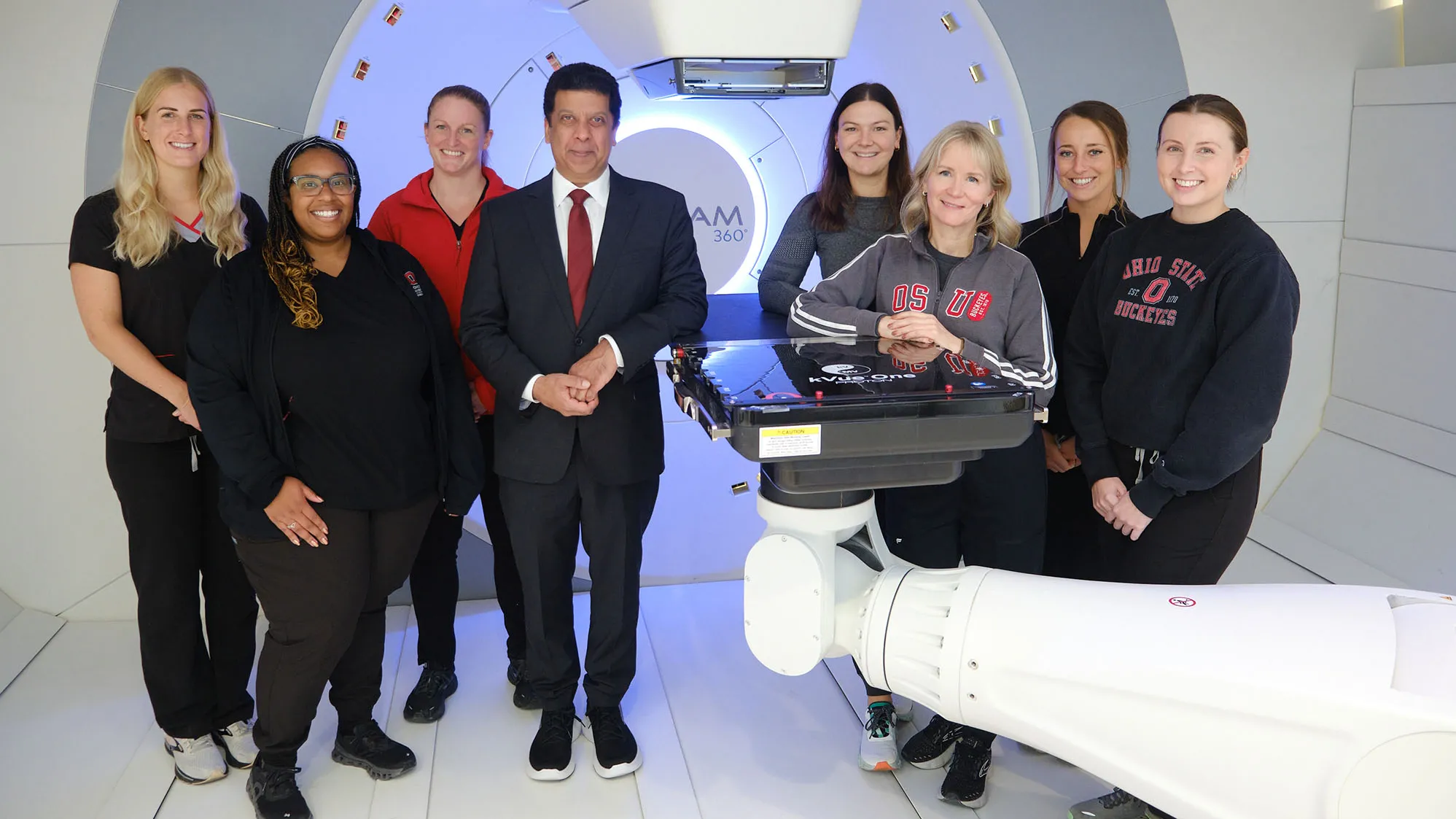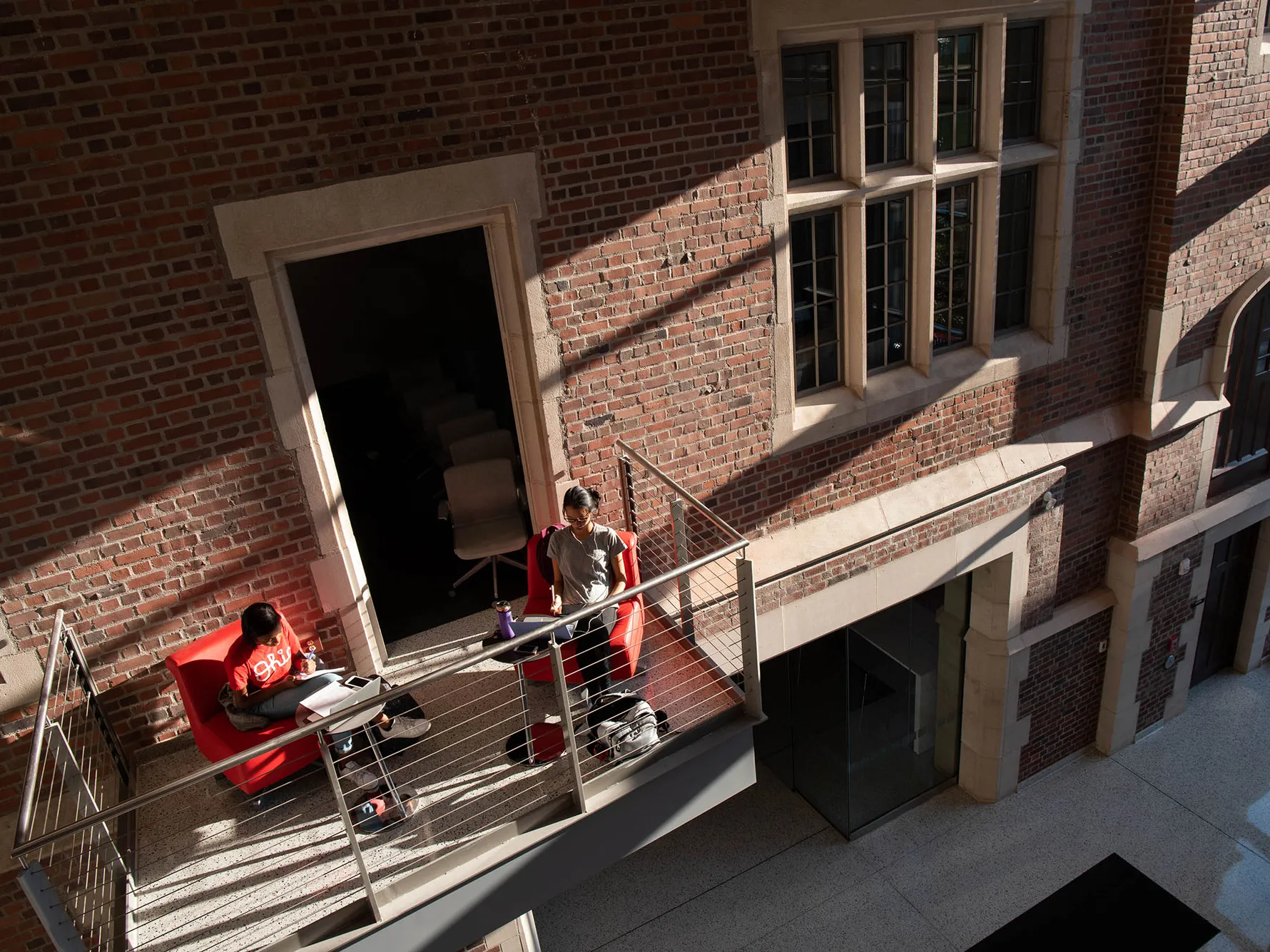Proton therapy center offers new hope for patients
A first for Central Ohio, the powerful new weapon in the fight against cancer can specially target tumors and promises more advancements in the future.

Proton therapy team members, from left, are Morgan Jostpille, Antonette Grandison, Jillian Cofojohn, Dr. Arnab Chakravarti, Kylee Warnecke, Julie Banner, Kristen Johnson and Nicole Pitzer. (Photo by Alan Geho)
When it comes to cancer treatment, it’s hard to overstate the power of positivity.
Now coming online at The James Outpatient Care, Ohio State’s proton therapy center leverages brand-new technology to give cancer patients a highly advanced treatment option and big dose of hope.
Proton therapy, which uses the positively charged particles of atoms to painlessly target tumor cells, has the potential to improve patient outcomes while minimizing complications.
Dr. Arnab Chakravarti, chair of the Department of Radiation Oncology and Klotz Chair in Cancer Research in the College of Medicine, has spent the past decade developing the technology to make the new center possible. Now, in collaboration with multidisciplinary teams at The Ohio State University Comprehensive Cancer Center – Arthur G. James Cancer Hospital and Richard J. Solove Research Institute (OSUCCC – James) and Nationwide Children’s Hospital, he is writing a new chapter in cancer treatment in central Ohio.
Here, he discusses the new approach.
-
Q: What advantages does proton therapy offer over conventional radiation?
A: Proton therapy deposits the entire radiation dose straight into the tumor while minimizing the effects on healthy surrounding tissue. Typically, patients experience fewer side effects and higher survival rates as a result. Their chances of developing secondary cancer due to radiation treatments are also lower.
-
Q: Who will benefit most?
A: The size and physiology of our pediatric patients can make traditional radiation more difficult to administer and riskier in the long run. Proton therapy will be a game-changer for these patients by sparing them from harmful effects of radiation and helping them avoid radiation-induced cancers in adulthood.
We also find that patients with cancers in the head, neck and central nervous system are good candidates for proton therapy. This option gives them a much higher chance of avoiding neurocognitive side effects.
The third group that will benefit is patients with recurring cancers. These patients have typically received the highest possible dose of conventional radiation. In many cases, they are also maxed out on chemotherapy and immunotherapy. Proton radiation may be their last and best hope for a cure.
-
Q: Proton therapy sounds very promising. Why are we only hearing about it now?
A: It took technology time to evolve. Traditional proton therapy platforms can’t shape the beam of protons around the geometry of the tumor as precisely as physicians would like. We could still deposit most of the radiation dose at the tumor’s edge but would end up treating more normal tissue than desired.
Since joining Ohio State in 2009, my team has worked with corporate partners to develop a new technology platform, multiroom ProBeam 360, which was just approved by the Food and Drug Administration. This platform utilizes technology called pencil beam scanning, which allows us to shape the beam with superior precision.
Another advantage is that the head of the device used to administer radiation has complete 360-degree rotation, allowing us to attack a tumor from every angle. We are researching a further leap in technology called FLASH, which would allow us to deliver a total dose of radiation faster than the blink of an eye.
-
Q: Why is Ohio State the right place to launch this center?
A: We have all the expertise we need under one roof to make this center a success. I lead a multidisciplinary team of physicians, medical physicists, engineers, IT specialists, AI and machine learning experts, radiation biologists and cancer biologists who are committed to achieving the best possible outcomes for our patients. The story of proton therapy is still being written, and we are writing it here at Ohio State.
-
Q: How can alumni help?
A: As we prepare to treat our first patients shortly before Christmas, we need help spreading the word about the lifesaving potential of proton therapy. If you know someone who might be a good fit for our program, please send them our way. We will also continue to rely on philanthropic support to build and improve our infrastructure so we can treat as many patients as possible.
x
Outpatient care center offers range of services
The James Outpatient Care is a new cancer-focused center in the Carmenton innovation district on West Campus. Learn more about its services at go.osu.edu/jamesoutpatient.
One-stop clinics
From clinics specializing in specific cancers to those focusing on topics such as genetic counseling and aging, patients can receive all of the medical procedures, drug therapies, mental health support and other clinical services they need in one location.
Surgery
Surgical treatments for some types of cancer can now be offered in an outpatient setting. The James Outpatient Care offers up to 24 hours of postsurgical care for services like plastic and reconstructive surgery, robot-assisted gynecologic surgery and soft-tissue biopsies.
Imaging
The James’ imaging suite is equipped with advanced tools, including nuclear medicine and a positron emission tomography (PET) scanner, to enhance cancer diagnosis and treatment.
Pathology services
Advanced digital technology allows radiologists and oncologists to view images of biopsies and tissue samples in real time, helping them deliver faster, more accurate diagnoses.



